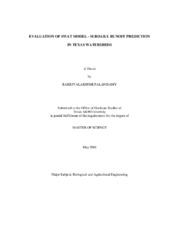| dc.contributor.advisor | Raghavan, Srinivasan | |
| dc.creator | Palanisamy, Bakkiyalakshmi | |
| dc.date.accessioned | 2007-09-17T19:38:06Z | |
| dc.date.available | 2007-09-17T19:38:06Z | |
| dc.date.created | 2003-05 | |
| dc.date.issued | 2007-09-17 | |
| dc.identifier.uri | https://hdl.handle.net/1969.1/5921 | |
| dc.description.abstract | Spatial variability of rainfall is a significant factor in hydrologic and water
quality modeling. In recent years, characterizing and analyzing the effect of spatial
variability of rainfall in hydrologic applications has become vital with the advent of
remotely sensed precipitation estimates that have high spatial resolution. In this study,
the effect of spatial variability of rainfall in hourly runoff generation was analyzed using
the Soil and Water Assessment Tool (SWAT) for Big Sandy Creek and Walnut Creek
Watersheds in North Central Texas. The area of the study catchments was 808 km2 and
196 km2 for Big Sandy Creek and Walnut Creek Watersheds respectively. Hourly
rainfall measurements obtained from raingauges and weather radars were used to
estimate runoff for the years 1999 to 2003. Results from the study indicated that
generated runoff from SWAT showed enormous volume bias when compared against
observed runoff. The magnitude of bias increased as the area of the watershed increased
and the spatial variability of rainfall diminished. Regardless of high spatial variability,
rainfall estimates from weather radars resulted in increased volume of simulated runoff.
Therefore, weather radar estimates were corrected for various systematic, range-dependent
biases using three different interpolation methods: Inverse Distance
Weighting (IDW), Spline, and Thiessen polygon. Runoff simulated using these bias adjusted radar rainfall estimates showed less volume bias compared to simulations using
uncorrected radar rainfall. In addition to spatial variability of rainfall, SWAT model
structures, such as overland flow, groundwater flow routing, and hourly
evapotranspiration distribution, played vital roles in the accuracy of simulated runoff. | en |
| dc.format.extent | 684690 bytes | en |
| dc.format.medium | electronic | en |
| dc.format.mimetype | application/pdf | |
| dc.language.iso | en_US | |
| dc.publisher | Texas A&M University | |
| dc.subject | rainfall spatial variability | en |
| dc.subject | hydrologic model | en |
| dc.subject | bias correction | en |
| dc.subject | weather radar rainfall | en |
| dc.title | Evaluation of SWAT model - subdaily runoff prediction in Texas watersheds | en |
| dc.type | Book | en |
| dc.type | Thesis | en |
| thesis.degree.department | Biological and Agricultural Engineering | en |
| thesis.degree.discipline | Agricultural Engineering | en |
| thesis.degree.grantor | Texas A&M University | en |
| thesis.degree.name | Master of Science | en |
| thesis.degree.level | Masters | en |
| dc.contributor.committeeMember | Haan, Patricia | |
| dc.contributor.committeeMember | Wilcox, Bradford | |
| dc.type.genre | Electronic Thesis | en |
| dc.type.material | text | en |
| dc.format.digitalOrigin | born digital | en |


